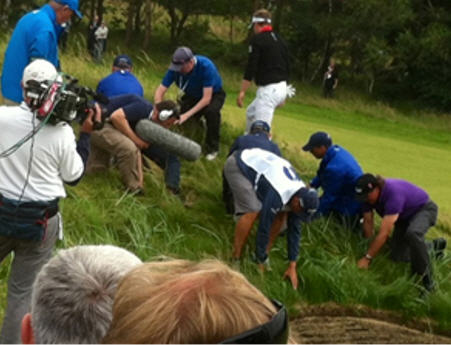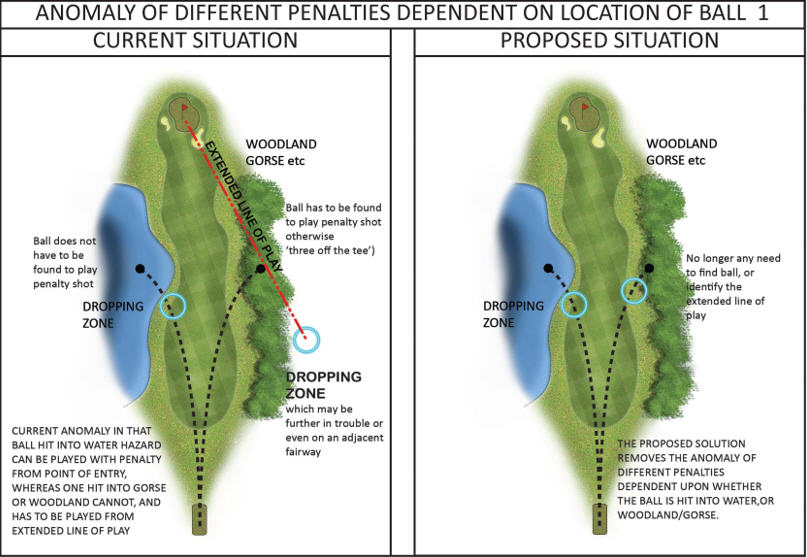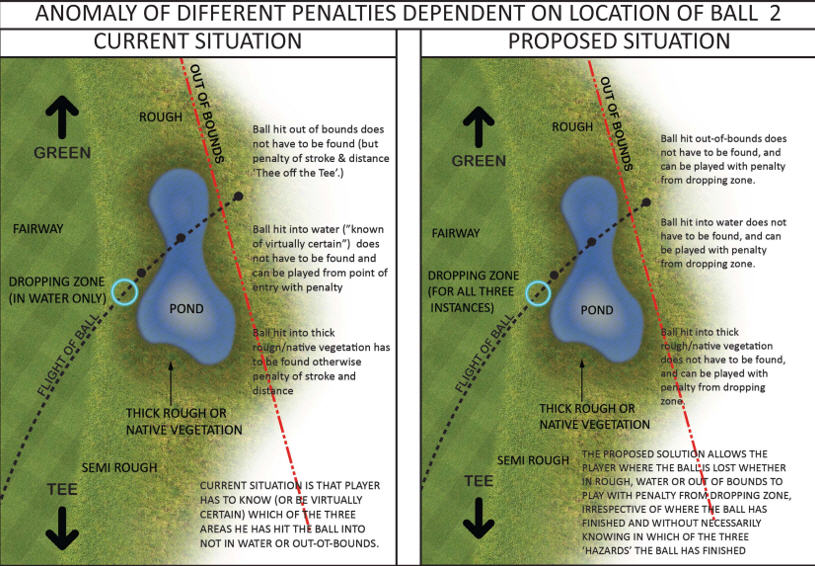A Proposed Simplification of the Rules of Golf, by Ken Moodie and David Williams, Past Presidents of the European Institute of Golf Course Architects

The game of golf is long overdue a major overhaul of the rules that govern it as the R & A and the USGA have recognised in their recently published draft amendments to the current rules. However, while the proposals aimed at speeding up play and simplifying the rules are very welcome we do not believe they have gone far enough. The golfing bodies have indicated that they might be open to altering the “stroke and distance” rule for a lost ball and have asked for an innovative solution. This article responds to this challenge but proposes a more radical approach that we believe will bring significant benefits to the game and be much easier for golfers to understand which will allow them to apply the rules correctly.
As background, a couple of years ago, we approached the R & A to propose a rule change which would allow ball finding devices to be used by golfers in competition. The purpose was to enable golfers to find their golf balls quickly, in order to speed up play, and to get rid of such a frustrating element of the game of golf; namely the lost ball. Finding a ball in deep rough within the allotted time requires good eyesight (to spot where the ball landed at distance), a fair level of luck, and owes a great deal to the searching skills of the golfers you happen to be playing with. For some reason the proposal to allow ball finding devices did not find favour, since it has not made it into the draft revision of the rules, but it did have one weakness as a concept which we recognised; namely, the fact that when a ball becomes lost it has often ended up in an unplayable area of the course, such as deep rough, where playing the ball or dropping another within two club lengths may prove futile. The option to drop a ball back on the extended line of play will often take the golfer into deeper trouble and so the golfer is then left with the only option being to return to the place he played his original shot from, thereby wasting time as illustrated by the left-hand illustration below. We would propose that a ball landing in deep vegetation is given the same penalty as one ending up in a lateral water hazard in order to speed up play and make the game more enjoyable as shown in the right-hand illustration.

While we would still like to see ball-finding devices allowed within the game we believe that it should ideally be coupled with a more radical shake-up of the rules of golf which would overcome the problem of the lost ball and also reduce their complexity by combining a number of disparate rules as we will outline below.
For all cases where a ball has become unplayable when it is lost, out-of-bounds, in a water hazard (both normal and lateral), or enters an area of deep rough, dense shrubs or woodland, we would propose that the golfer should have three options available to him. At a penalty of one stroke he would be able to choose to do one of the following:
- a) Drop a ball within two club-lengths of where he determines that his ball had become lost or unplayable, but no nearer the hole.
- b) Drop his ball where it crossed the margin of the area he defines as unplayable.
- c) Return to the spot where he played the original shot and play another ball.
By taking the line of the shot back towards the place where he played the original shot, rather than as an extension of the line for the following shot, it will be it will be more likely that the golfer will find a playable lie on which to drop a ball and will be less likely to interfere with golfers playing on an adjacent hole. It would also be easier for the golfer to judge the line and distance of the subsequent shot, since he should still be on the hole he is playing, and require a shorter detour to play the next shot which will speed up play.
Some might argue that the proposed new rule reduces the penalty for both a lost ball and out-of-bounds. Given the fact that professional golfers in tournaments rarely lose a golf ball due to the assistance they receive from other players, caddies, spectators and the general public there is already an uneven playing field.
In singles match-play events the golfer may, or may not, be able to count on his opponent to help him search for the ball and in stroke-play one golfing group may offer more help than another. The R & A and USGA recognise the fact that many golfers in friendly competition, particularly in the USA, agree to allow golfers in their group to drop a ball at a one or two stroke penalty, close to where they lost it, so the rules do not reflect the common-sense approach taken by many players. The rules need to be changed to reflect this.
In relation to the out-of-bounds, this is less a feature of golf courses built in recent years than for older courses when it was once considered a sporting hazard to be integrated into the golf course. Increased margins between golf holes and boundaries, due to safety concerns and the threat of litigation, have reduced the number of balls that go out of bounds. Where the property boundary lies close to play, and particularly where it borders houses or a busy road, the last thing you want to ask a player who puts their ball out of bounds is to play another from the same spot. They are likely to repeat the same error and endanger residents or road users a second time. It would be much better if they either dropped a ball within two club lengths of where their ball crossed the boundary fence, or on a line between where they played the original shot and the boundary. In this way they will be playing away from the boundary and less likely to repeat the same shot.
Designating water hazards and their surrounding banks as optional “unplayable areas”, and changing the dropping options to those outlined above, will mean that there will be no need for both yellow and red stakes, or any stakes at all for that matter. The player will not need to know the difference between the two types of water hazard and the rulings that apply to each. You will no longer need to be “virtually certain” that your ball has entered the water hazard in order to avoid the larger penalty of a lost ball since the penalty will be the same for both situations. Similarly, when a ball lands close to a boundary which is bordered by unplayable deep rough or thick vegetation there will be no need to search for 5 minutes (or 3 under the proposed revision to the Rules of Golf) to see if the ball has crossed the boundary to benefit from a lesser penalty of dropping near to where the ball landed. This will again speed up play. We have illustrated the various possible rulings related to a lost ball, lateral water hazard and out-of-bounds in the sketches below to show how important the honesty and integrity of the golfer (and his playing partners) is in determining where his ball ended up since he will currently benefit greatly if he can say his ball ended up in the water hazard in this situation rather than the alternatives. If our rule-change is adopted the same penalty drop options would apply to all.

The proposed rule change would allow golf courses to be managed with more areas of natural vegetation since there will be less concerns of lost balls slowing down play. Water hazards and course boundary fences could be fringed with longer rough without having to worry about golfers needing to see quickly if their ball has stayed short of the hazard or gone into it.
Golf needs to change to suit the needs of today’s golfer and be responsive to environmental requirements without increasing the time it takes to play a round. Simplifying the rules as we have outlined will make the game easier for golfers to understand and more likely for golfers to apply the rules correctly. It will also remove much of the frustration of a lost ball, since the penalty will be significantly reduced, which will mean that golfers will be less likely to search for the allotted time thereby speeding up play further.
Written by Ken Moodie & David Williams, Past Presidents of the European Institute of Golf Course Architects. Contact ken@creativegolfdesign.com
Please use twitter hashtag #onerulegolf
